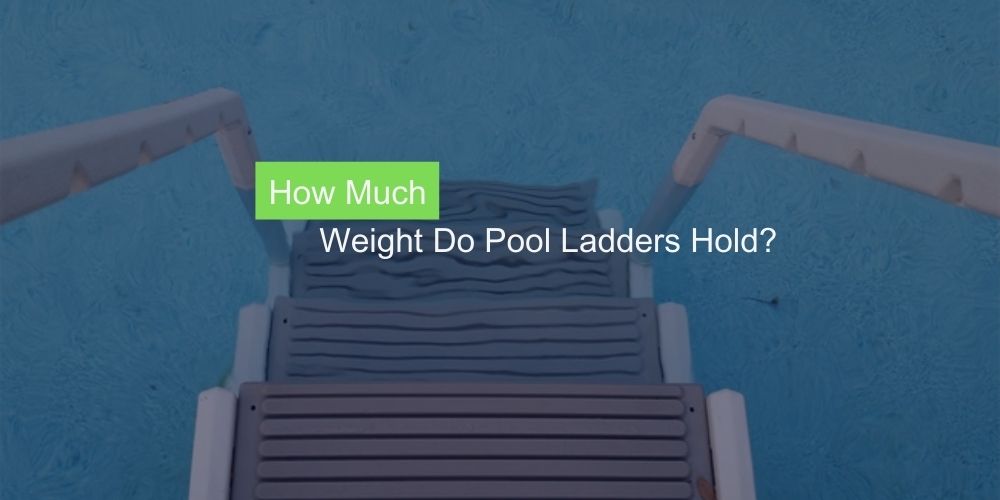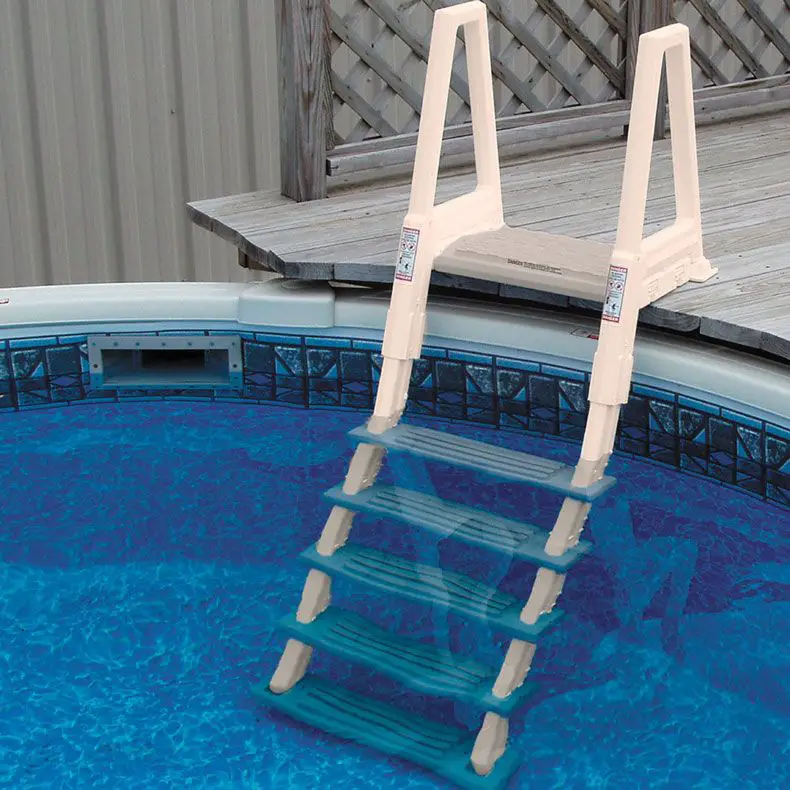
Having a pool in your backyard is a fantastic way to beat the summer heat and enjoy some refreshing water activities.
It’s, however, essential to ensure the safety of everyone using the pool, especially when it comes to pool ladders.
In this article, we will explore the weight capacities of pool ladders, providing you with valuable information to ensure a safe and enjoyable swimming experience.
How Much Weight Do Pool Ladders Hold?

For above-ground pools with flat bottoms, pool ladders are designed to accommodate different weight capacities. The specific weight limit can vary depending on the ladder’s construction and intended use.
However, a commonly available pool ladder for above-ground pools typically fits decks up to 60 inches in height and can hold a weight capacity of up to 400 lbs.
Always choose a ladder that comfortably accommodates the anticipated weight of users to ensure their safety. Additionally, following proper installation and maintenance guidelines and distributing weight evenly will help maximize the ladder’s lifespan and functionality.
4 Weight Limits for Different Pool Ladder Types
Different types of pool ladders have varying weight limits. Here are some common types and their corresponding weight capacities:
1. A-Frame Pool Ladders
A-Frame pool ladders, also known as standard or adjustable ladders, typically have weight capacities ranging from 250 to 300 pounds (113 to 136 kilograms). These ladders feature two sides with steps or rungs connecting them, providing stability and support.
2. Deck-Mounted Pool Ladders
Deck-mounted pool ladders are attached to the pool deck or surrounding area. They are sturdier and often have higher weight capacities, usually ranging from 300 to 400 pounds (136 to 181 kilograms). These ladders are ideal for in-ground pools with elevated decks.
3. In-Pool Step Ladders
In-pool step ladders are designed to be installed inside the pool, providing convenient access for both above-ground and in-ground pools. These ladders typically have weight capacities between 250 and 350 pounds (113 to 159 kilograms).
4. Pool Stairs
Pool stairs are a popular choice for both aesthetics and functionality. With weight capacities ranging from 300 to 500 pounds (136 to 227 kilograms), pool stairs offer a comfortable and secure entry into the pool. They are often constructed with durable materials like stainless steel or resin.
5 Factors Affecting Pool Ladder Weight Capacity
Several factors can influence the weight capacity of a pool ladder. Here are some key factors that can affect the weight capacity:
1. Material and Construction
The material used and the overall construction of the ladder play a significant role in determining its weight capacity. Ladders made from sturdy materials such as stainless steel or heavy-duty aluminum tend to have higher weight capacities compared to those made from lightweight materials like plastic.
2. Design and Structure
The design and structure of the ladder also impact its weight capacity. Ladders with a robust and well-engineered frame, reinforced steps, and strong connections tend to support higher weights. The design should distribute the weight evenly to ensure stability and prevent any weak points.
3. Step Width and Spacing
The width and spacing of the ladder steps can affect its weight capacity. Wider steps or narrower spacing between the steps generally provide better support and can handle more weight. Ladders with closely spaced or narrow steps may have lower weight capacities.
4. Mounting and Anchoring
The method of mounting or anchoring the ladder to the pool deck or wall is important for weight capacity. Proper installation and secure anchoring ensure stability and increase the ladder’s weight-bearing capacity. Follow the manufacturer’s guidelines and use appropriate mounting hardware.
5. Usage Guidelines
The weight capacity specified by the ladder manufacturer is based on certain assumptions and usage guidelines. Exceeding the recommended weight limit can compromise the ladder’s stability and safety. It is essential to adhere to the manufacturer’s guidelines regarding weight restrictions.
Safety Measures for Pool Ladder Usage
While knowing the weight capacity of your pool ladder is essential, it’s equally important to follow some safety measures:
- Stay within the weight limit: Always ensure that the combined weight of individuals using the ladder does not exceed the specified weight capacity.
- Secure the ladder: Make sure the ladder is properly anchored and secured to the pool or deck, ensuring stability during use.
- Use non-slip materials: Consider adding non-slip materials or treads to the ladder’s steps or rungs to prevent accidents caused by slippery surfaces.
- Supervise children: Never allow unsupervised access to the pool ladder, especially for young children. Adult supervision is crucial to prevent accidents.
- Regular inspections: Routinely inspect your pool ladder for any signs of damage, wear, or corrosion. Replace any worn-out or damaged parts immediately.
How to Maintain and inspect your pool ladder
1. Regular Cleaning
Clean your pool ladder regularly to remove any dirt, debris, or algae that may accumulate on it. Use a mild detergent, pool-safe cleaner, and a soft brush to scrub the ladder thoroughly. Rinse it with clean water afterward.
2. Check for Damage
Inspect the ladder for any signs of damage or wear. Look for rust, loose or missing screws, cracked steps, or bent parts. Ensure that the ladder’s connections and hinges are secure.
3. Tighten Loose Parts
If you notice any loose screws or bolts, tighten them using the appropriate tools. This will help maintain the ladder’s stability and prevent accidents.
4. Lubricate Moving Parts
If your ladder has moving parts, such as hinges or folding mechanisms, lubricate them periodically with a silicone-based lubricant. This will ensure smooth operation and prevent rusting.
5. Test Stability
Before using the ladder, make sure it is stable and secure. Shake it gently to check for any wobbling or instability. If you notice any issues, repair or replace the ladder as necessary.
6. Store Properly
Store the ladder in a dry area away from direct sunlight and extreme temperatures during the off-season or when not in use. This will help prolong its lifespan and prevent damage.
FAQs: How Much Weight Do Pool Ladders Hold?
1. What can I use instead of a pool ladder?
Instead of a pool ladder, you can consider using alternatives like a pool step system, a pool deck with built-in steps, or a sloped entry system for easy access in and out of the pool.
2. Why won’t my pool ladder stay down?
There could be several reasons why your pool ladder won’t stay down, such as a loose or broken hinge, insufficient weight or pressure, or improper installation.
3. Should I put something under my pool ladder?
Yes, placing a non-slip and protective mat or pad under your pool ladder is recommended to provide stability, protect the pool liner, and prevent slipping.
Final Words
Knowing the weight capacity of your pool ladder is vital for ensuring the safety of everyone using your pool.
Different types of ladders have varying weight limits, so choosing a ladder that suits your needs and adheres to the weight restrictions is crucial.

Hi, This is Josh. I am a former competitive swimmer and current fitness enthusiast.
I created this site to share my love of swimming with the world!

